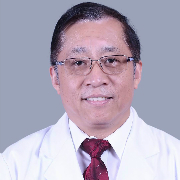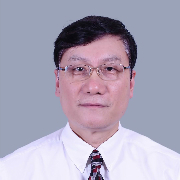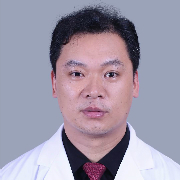-
- 薛兴阳副主任医师
-
医院:
广州医科大学附属肿瘤医院
科室:
胸外科
- 食管手术吻合口的愈合过程
- 颈交感神经麻痹综合征
- 肺鳞癌的治疗
- Pancoast瘤与Panco...
- 上腔静脉综合征
- 结节病的诊断鉴别
- 14届世界肺癌大会主要内容
- 外科病理检查你了解多少?
- 癌症治疗后随访内容及意义
- 哪些人容易得肺癌
- 肺癌治疗的几大“瓶颈”
- 我院地址及门诊时间
- 广州医科大学5.18揭牌 学校...
- 肺癌围手术期肺保护
- 晚期非小细胞肺癌的维持治疗策略
- 广州医学院正式更名为广州医科大...
- 广州市陈建华市长视察我院
- 医学界是如何运用仪器诊断肺癌
- 肺结节患者的处理
- 肺硬化性血管瘤
- 肺癌筛查的必要性
- 高强度超声聚焦刀(海扶刀)的适...
- 我们科室-肺肿瘤科简介
- 基于分子靶点的非小细胞肺癌个体...
- 广州医学院附属肿瘤医院2013...
- 人生七宝
- 养 生 箴 言
- 气质的培养
- 早期肺癌几个信号
- 谈谈外科医生的素质
- 患者肺癌常见疑问
- 肿瘤外科的几个误区
- 肺尖癌、肺上沟癌与Pancoa...
- 乳腺巨大纤维瘤特点
- 食管贲门癌术后应用十二指肠营养...
- 我们时刻要记得??我们是“临床...
- 科研人生:抓住高尚的感觉[转]
- 癌症患者心理疏导的必要性
- 女性激素6项的常识及临床意义
- 行医感悟
- 外科医生的手术技巧 转载
- 《2012 非小细胞肺癌NCC...
- ACS:针对癌症存活者的第一份...
- 恶性胸腔积液的胸腔热疗
- 陀螺刀在肿瘤治疗中的应用
- 陀螺刀临床应用
- 薛兴阳已发表文章
- 肺癌筛查的处理流程??关于NC...
- 2011年NCCN老年肿瘤指南...
- 乳房疼痛如何治疗
- 2012年美国乳腺癌NCCN指...
- 胸腔手术后咳嗽很重要啊
- 肺癌手术后咳嗽也要学会
- 高龄肺癌患者也不应放弃手术治疗
- 关于生物标志物检测的几点思考
- 食道癌的常用治疗方法
- 老年肺癌手术后期如何处理肺癌
- 肺部肿瘤常用免疫组化抗体
- 乳腺癌新辅助化疗的理解与遵循原...
- 易瑞沙产生耐药后续治疗策略
- 一个癌细胞的自述
- 射频消融治疗肺癌
- 增殖细胞核抗原PCNA
- 肿瘤细胞的代谢特点
- 食管癌术前放疗
- 霍纳氏综合症
- 人生应有水的品质
- 医生给病人开的第一个处方是关爱...
- 上消化道出血
- 神经系统病变的定位定性诊断
- 学会感恩
- 常怀感恩之情
- 感恩医院
- 医者需常怀感恩之心
- 医生操守
- 幸福是什么
- 让患者有尊严是医生必备的职业精...
- 如何锻炼肺功能
- 如何提高医学生与外科手术病人的...
- 快乐是什么?
- 化疗后骨髓抑制分度及处理
- 食管手术吻合口的愈合过程
- 癌性贫血的临床研究进展
- 肺癌个体化治疗思路
- 肿瘤研究的新思路??组织微结构...
- 2011版《NCCN非小细胞肺...
- 乳腺良性肿瘤临床路径
- 日益增多的证据证实,在肿瘤专科...
- PET-CT与健康体检
- 乳腺X 线报告规范化
- 癌性脑膜炎
- 临床常用免疫组化指标的意义
- 肺癌的各种影像学检查原理及意义
- 实体瘤的疗效评价标准(RECI...
- 我总结的化、放疗的不良反应如何...
- 我总结的乳腺癌的出院指导的相关...
- 我总结的肿瘤标记物的相关科普,...
- 我总结的女性乳腺自检方法的相关...
- 我总结的肿瘤病人化疗期间如何自...
- 我总结的肿瘤化疗及化疗的误区的...
- 我总结的胸腔镜技术治疗胸部肿瘤...
- 我总结的乳腺癌病友常见疑问及答...
- 我总结的食管、贲门癌的相关科普...
- 我总结的肺癌的相关科普,希望对...
- 化疗引起的白细胞降低的药补和食...
- 熊果酸抗肿瘤作用研究进展
- 重复癌(应与转移癌相区别)
- 乳腺癌的预后都与那些因素有关?
- 如何解读乳腺癌免疫组化中的项目...
- 2011版NCCN乳腺癌指南更...
- 各种肺癌诊断手段简介
- PET和PET/CT能解决肿瘤...
- 癌细胞特征:不死性、迁移性和失...
- EGFR抑制剂耐药机制研究的新...
- 2009年St.Gallen早...
- 2009年St.Gallen早...
- EGFR-TKI耐药对策和困境
- 肿瘤标志物检测项目临床意义-肿...
- 肿瘤细胞免疫组化耐药预后标记的...
- 肺腺癌新分类??分子生物学视角
- 肺腺癌分类(2011版)
- 癌症是种慢性病 与其“和平共处...
- 微创介入技术成肿瘤治疗新趋势
- Patients,Pathwa...
- 糖尿病、肿瘤与糖尿病治疗研究进...
- 子宫内膜癌的诊疗规范
- 解析转移性乳腺癌的化疗原则及新...
- 如何治疗脂肪肝
- 屁是怎样产生的?放屁过多是由什...
- ASCO乳腺癌HER2检测指南
- 医院看病如何选择医院和医生,使...
- 挂号前做点“功课”,是您事半功...
- 2009年美国临床肿瘤学会(A...
- 细支气管肺泡癌之中国共识
- ESMO 小细胞肺癌临床实践指...
- 癌症治疗十大误区
- 什么是结节病?
- 食管癌化疗
- 临床上常见肿瘤标志物临床意义
- 乳腺癌保乳手术的适应证、禁忌证...
- “六大传说”耽误癌症治疗
- 治疗老年癌痛患者更要重视合理用...
- 癌痛治疗的误区
- 止癌痛应如何正确用药
- 抗癌效果最明显的蔬菜
- “乳腺癌”疗法面面观
- 乳腺癌术后怎样“消肿”?
- 气管肿瘤治疗进展
- EGFR突变
- 局部晚期非小细胞肺癌:“个体化...
- 乳腺癌预后生物学指标
- 纵膈镜的临床应用
- 今天和一个病人聊起,有感而发
- 2010 AATS肺癌外科进展
- 肺癌术后复查
- 分子靶向药物和化疗药物的分子测...
- 非手术治疗食管癌的临床分期标准...
- 房颤患者的八大误区
- 西妥昔单抗临床应用进展
- 肿瘤病人的营养指导
- 蒽环类化疗药物的研究进展
- 广泛期小细胞肺癌的治疗进展
- 肺癌的治疗靶点及相关药物开发
- 非小细胞肺癌新靶向药物治疗研究...
- 肺癌化疗新进展
- 肺癌研究百年回眸
- 乳腺癌新辅助化疗的共识与争议
- 肺癌术后恢复
- 揭秘不同癌症的蔬菜克星
- 乳腺癌化疗的常见不良反应及对策
- 癌症患者八成想知患病真相
- 肿瘤分子新靶点治疗药物的应用与...
- 九种人易患乳腺癌
- 乳腺癌化疗
- 你了解性激素检查的意义吗?
- 我院正式成为广州市基本医疗保险...
- 赫赛汀常见问答
- 2009广泛期小细胞肺癌治疗进...
- 肺癌生物治疗新进展
- 肺癌研究的热点
- 肿瘤靶向声学造影剂的研究现状
- 肿瘤靶向给药系统的研究进展
- 抗肿瘤抗生素研究进展
- 结直肠癌早期检测的基因标志物
- 肿瘤分子靶向治疗进展、问题及思...
- 常见肿瘤综合治疗的几种模式
- 恶性肿瘤骨转移的综合治疗
- 肺癌靶向治疗研究进展
- 如何合理治疗晚期乳腺癌?
- 端粒酶与胃、结肠肿瘤的关系及其...
- 非霍奇金淋巴瘤治疗新认识
- 2006美国临床肿瘤学年会:乳...
- 乳腺叶状肿瘤的研究进展
- 肿瘤局部热疗与抗肿瘤免疫
- 肿瘤新生血管理论??佛克曼
- 癌性贫血的临床研究进展
- 肿瘤靶向治疗
- 推荐中国妇女的乳腺癌筛查方法
- 食管癌的放疗规范
- 肺癌化疗的新进展
- 肺癌常识
- 小细胞肺癌脑预防照射的最佳时间...
- 肺癌为何也青睐女性
- 肿瘤细胞多药耐药机理的研究进展
- 对抗癌症
- 癌症大国
- 脑盐耗综合征
- 判断肿瘤预后的免疫组化标志物
- 免疫组化
- 晚期非小细胞肺癌 从一线治疗、...
- 解析2009版《NCCN NS...
- 广泛期小细胞肺癌一线治疗进展
- 小细胞肺癌治疗进展
- ACCP《肺癌诊断和治疗指南》...
- 放射治疗在N2非小细胞肺癌中的...
- 小细胞肺癌(SCLC)
- 《NCCN临床实践指南(200...
- 解读2009版NCCN乳腺癌临...
- 食管癌的TNM分期(UICC ...
- 中国肺癌治疗现状
- 《NCCN临床实践指南:非小细...
- 肺癌的外科扩大治疗
- 只要发现早 七成肺癌能治好
- “找到差距,才能进步”
- 2009 年国际肺癌分期与临床...
- 肺部肿瘤常用免疫组化抗体:
- 肺癌术前准备
- 乳腺癌的防治常识
- 乳腺癌保乳手术的若干问题探讨
- ASCO 2009肺癌研究主题...
- 支气管肺泡细胞癌之中国共识
- 乳腺癌内分泌治疗的现状
- 食管癌手术辅助化疗的进展
- 非小细胞肺癌NSCLC的放射治...
- 肺癌脑转移瘤的诊断与治疗
- 决定患侧上肢水肿的几个因素
- 基底样乳腺癌的分子特征
- 恶性肿瘤防治
- 小细胞肺癌治疗新进展
- 肺癌骨转移的治疗
- 结核病人几种食物必须慎食
- 缩唇呼吸有助改善肺功能
- 放射治疗的临床应用
- miRNA:肺癌新发病机制与药...
- 乳腺癌化疗的现状及应注意的几个...
- 肺癌的多学科治疗
- 非小细胞肺癌的化疗进展
- 化疗病人的辩证饮食护理
- 化疗当天如何安排饮食才能减轻化...
- 化疗期间的癌症病人怎样增加食欲...
- 哪些因素影响乳腺癌的治疗效果?
- 如何监测乳腺癌的复发、转移?
- 乳腺癌保乳的条件
- 什么是乳腺增生
- 放射性食管炎治疗验方
- 专家详解如何读懂肝功化验单
- 食管癌饮食疗法
- 食管癌术后的饮食原则
- 食管癌手术前应作哪些准备?
- 食管癌最先需要外科治疗
- 肺癌免疫治疗进展
- 好的肺癌治疗方案很重要
- 肺癌的分子靶向治疗
- 食道癌术后转变错误治疗观念
- 肺癌的TNM分期(UICC 2...
- 化放疗的不良反应如何处理
- 肿瘤病人化疗期间如何自我恢复?
- 肿瘤食疗方三红汤
- 肿瘤化疗及化疗的误区
- 胸腔镜技术治疗胸部肿瘤
- 化疗、放疗的起始时间
- 乳腺癌患者能否过性生活?
- 乳腺癌患者能结婚生育哺乳吗?
- 乳腺癌患者的饮食
- 影响乳腺癌预后的因素
- 乳腺癌保乳治疗
- 乳腺癌的特色检查
- 乳腺癌发病与哪些因素有关?
- 食管癌及贲门癌患者术后饮食注意...
- 食管癌、贲门癌常见症状及需要的...
- 食管癌高发的主要因素
- 肺癌病人的饮食调理
- 肺癌规范化治疗
- 肺癌的检查与诊断
- 肺癌的常见症状
- 肺癌的高发因素有哪些?
- 乳腺癌患者的随诊
- 三苯氧胺与乳腺癌研究进展
- 复发或转移性乳腺癌的诊断和治疗...
- 远离乳腺癌复发
- 三阴乳腺癌的生物学特征与治疗策...
- 乳癌手术前后内科治疗最佳策略的...
- 乳腺癌术后的功能锻炼
- 正确使用集落刺激因子
- 非小细胞肺癌内科治疗的现状及进...
- 妇女便秘易患乳腺癌
- 如何预防化疗引起白细胞下降?
- 骨肉瘤肺转移的外科治疗
- 美国声嘶治疗指南发布
- 作者:薛兴阳|发布时间:2009-11-03|浏览量:601次
National guideline released for the treatment of hoarseness
Alexandria, Va. - The American Academy of Otolaryngology ? Head and Neck Surgery Foundation (AAO-HNSF) will issue the first--and only--national clinical practice guideline to help healthcare practitioners identify and manage patients with hoarseness, also known as dysphonia. The guideline emphasizes evidence-based management of hoarseness by clinicians, and educates patients on the prevalence of this common vocal health issue.广州医学院附属肿瘤医院胸外科薛兴阳
"Hoarseness affects approximately 20 million people in the U.S. at any given time, and about one in three individuals will become hoarse at some point in their life," said Richard M. Rosenfeld, MD, MPH, an author of the guideline and chair of the AAO-HNSF Guideline Development Task Force. "In addition to the impact on health and quality of life, hoarseness leads to frequent healthcare visits and several billion dollars in lost productivity annually from work absenteeism."
The terms hoarseness and dysphonia are often used interchangeably, however, hoarseness is a symptom of altered voice quality and dysphonia is a diagnosis. Hoarseness (dysphonia) is defined as a disorder characterized by altered vocal quality, pitch, loudness, or vocal effort that impairs communication or reduces voice-related quality of life. Hoarseness may affect newborns, infants, children, and adults of any age. Individuals with hoarseness have impaired communication with their family and peers, which may result in depression, social isolation, missed work, lost wages, or reduced quality of life.
"Most hoarseness is caused by benign or self-limiting conditions, but it may also be the presenting symptom of a more serious or progressive condition requiring prompt diagnosis and management," said Seth R. Schwartz, MD, MPH, chair of the Hoarseness Guideline Panel. "This new guideline is intended to enhance diagnosis, promote appropriate therapy, improve outcomes, and to expand counseling and education for prevention."
Hoarseness is more common in women (50% higher than men), children (peak range 8-14 years), the elderly, and professional voice users (e.g., teachers, performers, telemarketers, aerobics instructors). In spite of how common the condition is, a recent survey by the AAO-HNS revealed that many Americans are unfamiliar with the possible causes and appropriate treatment for hoarseness. The survey revealed that almost half of adults are not aware that persistent hoarseness may be a symptom of cancer. Separate research cited in the guideline also found that only 5.9 percent of those with hoarseness seek treatment.
Recognizing that patients who do seek care may see many different types of healthcare providers, the guidelines are intended for all clinicians who are likely to diagnose and manage patients with hoarseness.
Key features of the new guideline include:
1.Most, but not all, hoarseness is the result of benign underlying or self-limiting factors; however, clinicians should consider the possibility of a serious underlying condition (growth or tumor of the larynx) or medication side effects as a cause.
2.Laryngoscopy is an office procedure to visualize the larynx (voice box and vocal cords) that should be performed if hoarseness persists or if the cause is uncertain.
3.Imaging studies, such as a CT or MRI scans, should not be obtained for a primary complaint of hoarseness prior to visualizing the larynx; laryngoscopy is the primary diagnostic modality and should be done first.
4.Anti-reflux medicines should not be prescribed for hoarseness unless there are (a) signs or symptoms of gastroesophageal reflex disease (GERD), such as heartburn or regurgitation, or (b) signs of inflammation of the larynx seen during laryngoscopy.
5.Steroids or antibiotics given by mouth are not recommended for hoarseness and should not be used routinely.
6.Voice therapy is a well-established intervention for hoarseness that can be performed at any age. Laryngoscopy should be performed prior to voice therapy and results communicated to the speech-language pathologist. Therapy for hoarseness usually includes one to two sessions per week for four to eight weeks.
7.Surgery is not the primary treatment for most hoarseness, but may be indicated for suspected cancer, other tumors or growths, abnormal movement of the vocal cords, or abnormal tone of the vocal cord muscles.
8.The risk of hoarseness may be reduced by preventive measures such as staying well-hydrated, avoiding irritants (especially tobacco smoke), voice training, and amplification during heavy voice use.
"In an era of health reform and comparative effectiveness research, well-crafted guidelines help improve quality, promote optimal outcomes, minimize harm, and reduce inappropriate variations in care," says Dr. Rosenfeld. "It is hoped that these guidelines will give clinicians the tools they need to spot an issue early, avoid poor outcomes, and reduce healthcare costs."
The guideline was created by a multidisciplinary panel representing neurology, speech-language pathology, professional voice teaching, family medicine, pulmonology, geriatric medicine, nursing, internal medicine, otolaryngology ? head and neck surgery, pediatric medicine, and consumers.
TA的其他文章:




